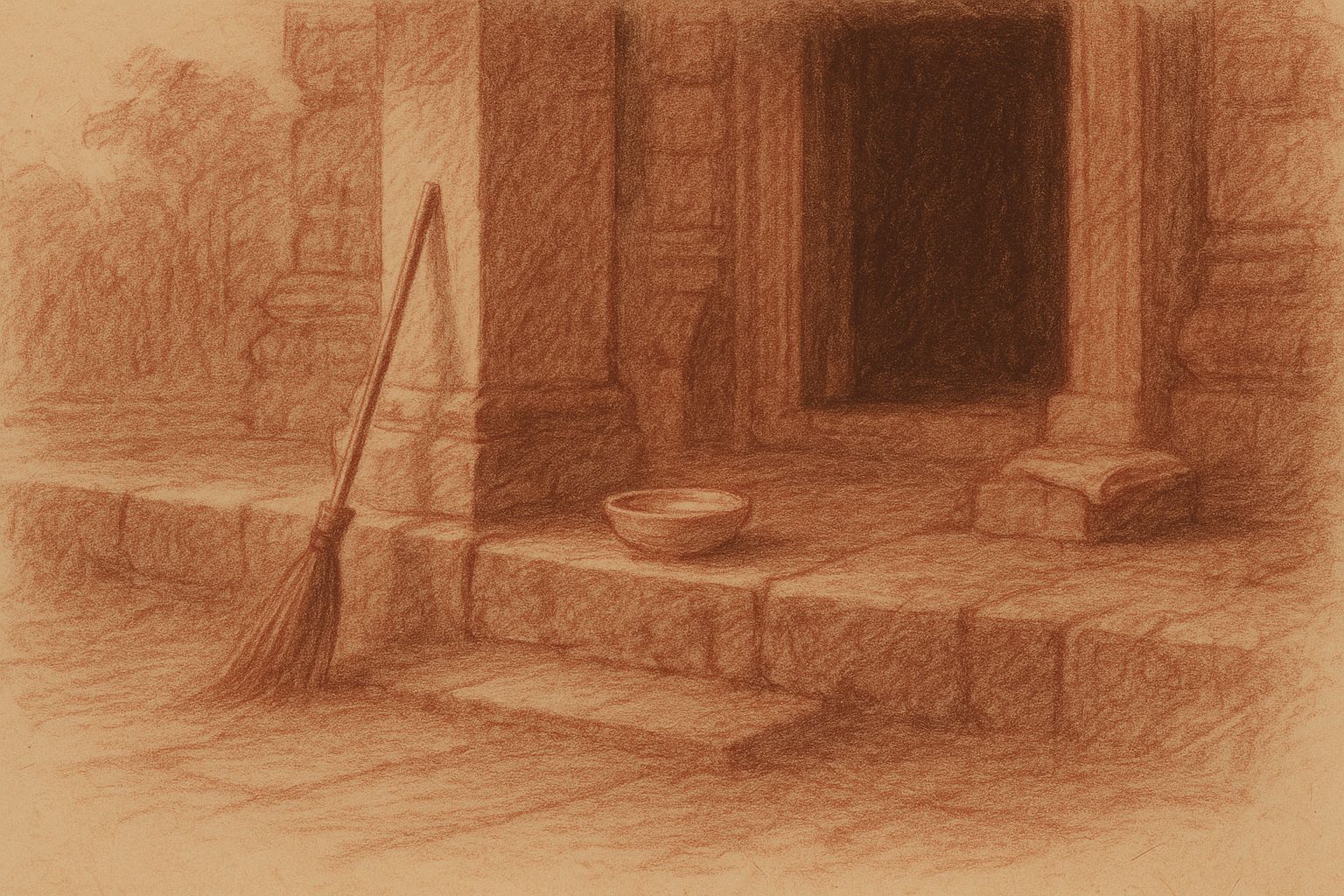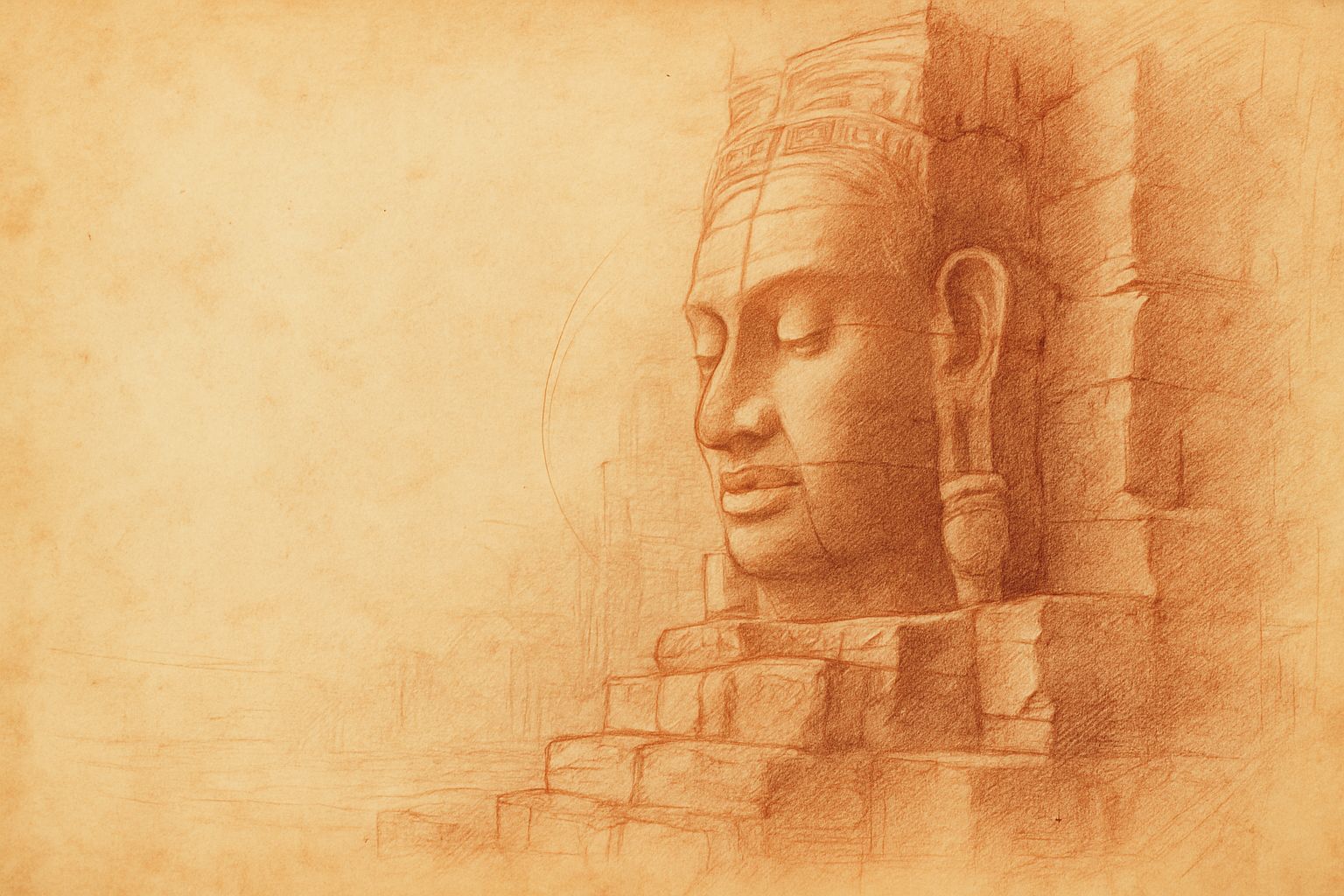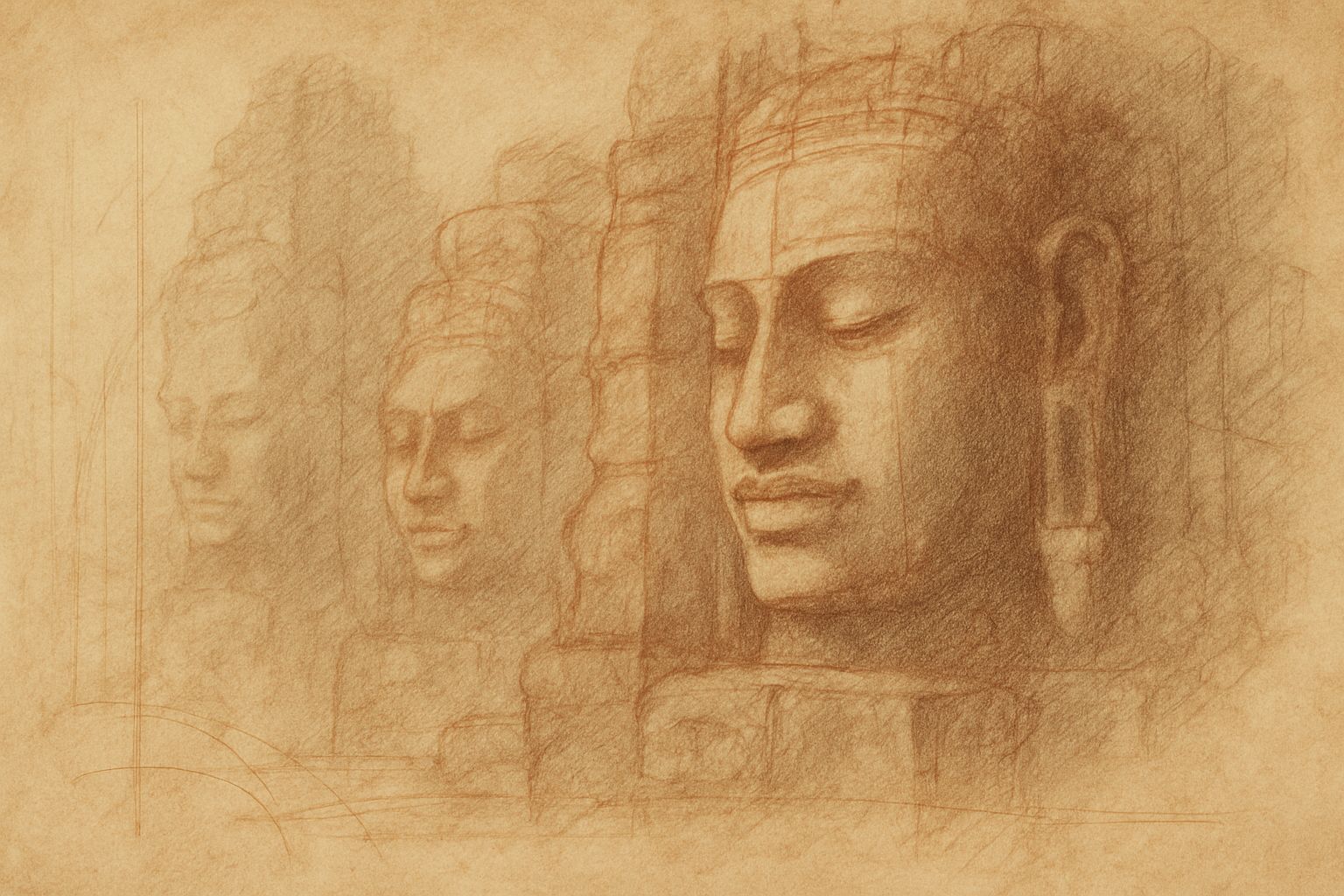Complimentary worldwide shipping on orders over $400 · No import tariffs for most countries
Complimentary worldwide shipping on orders over $400 · No import tariffs for most countries

Where Silence Holds the Shield
In the hush of the western gallery, battle yields to breath, and light becomes a prayer pressed into stone.
A lone warrior stands—neither fleeing nor triumphant—beneath a glow that speaks not of war, but of remembrance.
Carved across nearly fifty meters of sandstone, the Battle of Kurukshetra unfolds in waves of chariots and warriors—a crescendo of divine conflict drawn from the Mahabharata. Yet here, in this image, the tumult dissolves. Only one figure remains. Shield lifted, body stilled, he hovers between resistance and surrender. His gesture is not action, but pause—not conquest, but contemplation. The myth falls quiet, and story becomes presence.
The photograph was made slowly. Lucas Varro entered the sacred corridor with a large format analogue camera, alone in the silence of a world suspended. He waited as the fading sun, filtered through the jungle canopy, brushed the walls with a strange green-gold glow. He did not seek to compose, but to receive. When the moment opened, he exposed the film in one long breath of reverence.
In the solitude of the studio, the ritual continued. Chiaroscuro shaped the negative like shadow carved into bone—guiding the eye through quiet rather than contrast. Hand-toning followed, not for ornament but remembrance. Layer by layer, washes of gold and ash were coaxed into the print until it held the atmosphere of that hour: something not seen, but felt. The result is not a reproduction, but a return. A devotional artefact shaped by the same silence that once held the shield aloft.
Created as part of the Spirit of Angkor series, this photograph is not a record of myth—it is its echo. For the spiritually attuned collector, it offers not a story to behold, but a space to enter. A still point. A breath suspended in stone. A light that does not strike, but listens.
Each print is crafted on museum-grade Hahnemühle Bamboo paper, known for its soft tactility and tonal richness. The edition is strictly limited to 25, with 2 Artist’s Proofs, each one hand-toned, signed, and numbered. Accompanied by the artist’s Field Journal, poems, and curatorial texts, the work becomes a place to return to—again and again—where the fever of myth gives way to the stillness that endures.
Also in Library

Those Who Keep the Way Open — On the Quiet Guardians of Angkor’s Thresholds
3 min read
Quiet gestures shape the way into Angkor — a swept stone, a refilled bowl, a hand steadying a guardian lion. This essay reflects on the unseen custodians whose daily care keeps the thresholds open, revealing how sacredness endures not through stone alone, but through those who tend its meaning.

Multiplicity and Mercy — The Face Towers of Jayavarman VII
5 min read
A new vision of kingship rises at the Bayon: serene faces turned to every horizon, shaping a world where authority is expressed as care. Moving through the terraces, one enters a field of steady, compassionate presence — a landscape where stone, light, and time teach through quiet attention.

Stone That Dreams
4 min read
Bayon wakes like a mind emerging from shadow. Its many faces shift with light and breath, teaching that perception—and the self—is never singular. In walking this forest of towers, the pilgrim discovers a quiet multiplicity within, held together by a calm that feels both ancient and newly understood.
Angkor Wat Temple, Cambodia — 2020
Limited Edition Archival Pigment Print
Edition
Strictly limited to 25 prints + 2 Artist’s Proofs
Medium
Hand-toned black-and-white archival pigment print on Hahnemühle Bamboo — a museum-grade fine art paper chosen for its quiet tactility and reverent depth, echoing the spirit of the temples.
Signature & Numbering
Each print is individually signed and numbered by the artist on the border (recto)
Certificate of Authenticity
Accompanies every print
Image Size
8 x 8 inches (20.3 x 20.3 cm)
“There is a radiance that survives the clang of swords.”
A golden hush settles upon Angkor Wat’s western gallery. Here, the mythical Battle of Kurukshetra no longer roars; it breathes. A lone warrior—shield lifted—stands in the after-silence where conflict surrenders to memory. Late-afternoon light glides across the relief, awakening an inner glow that seems to rise from the stone itself.
During a solitary visit in 2020, photographer Lucas Varro waited, listening for that subtle radiance. Exposing large-format black-and-white film in a single, patient breath, he received the scene rather than seized it. In the darkroom he coaxed warmth into silver, hand-toning each print with whispers of gold that echo the canopy-filtered light of that evening.
Printed on museum-grade Hahnemühle Bamboo, renowned for its velvety surface and sustainable heart, every sheet becomes a quiet sanctuary for tone and texture. Limited to 25 signed prints (+ 2 Artist’s Proofs), the work offers permanence not only in craft but in contemplative presence.
Should this image find its way to your wall, may it stand as a still point—an illuminated threshold where stone remembers, and light speaks without sound.
Follow the quiet path into the Artist’s Journal to wander deeper into this hush.
Previously titled ‘Battle of Kurukshetra I, Study II, Angkor Wat Temple, Cambodia. 2020,’ this photograph has been renamed to better reflect its place in the series and its spiritual tone. The edition, provenance, and authenticity remain unchanged.
Join My Studio Journal
Receive occasional letters from my studio in Siem Reap—offering a glimpse into my creative process, early access to new fine art prints, field notes from the temples of Angkor, exhibition announcements, and reflections on beauty, impermanence, and the spirit of place.
No noise. No clutter. Just quiet inspiration, delivered gently.
Subscribe and stay connected to the unfolding story.

Join My Studio Journal
Receive occasional letters from my studio in Siem Reap—offering a glimpse into my creative process, early access to new fine art prints, field notes from the temples of Angkor, exhibition announcements, and reflections on beauty, impermanence, and the spirit of place.
No noise. No clutter. Just quiet inspiration, delivered gently.
Subscribe and stay connected to the unfolding story.

